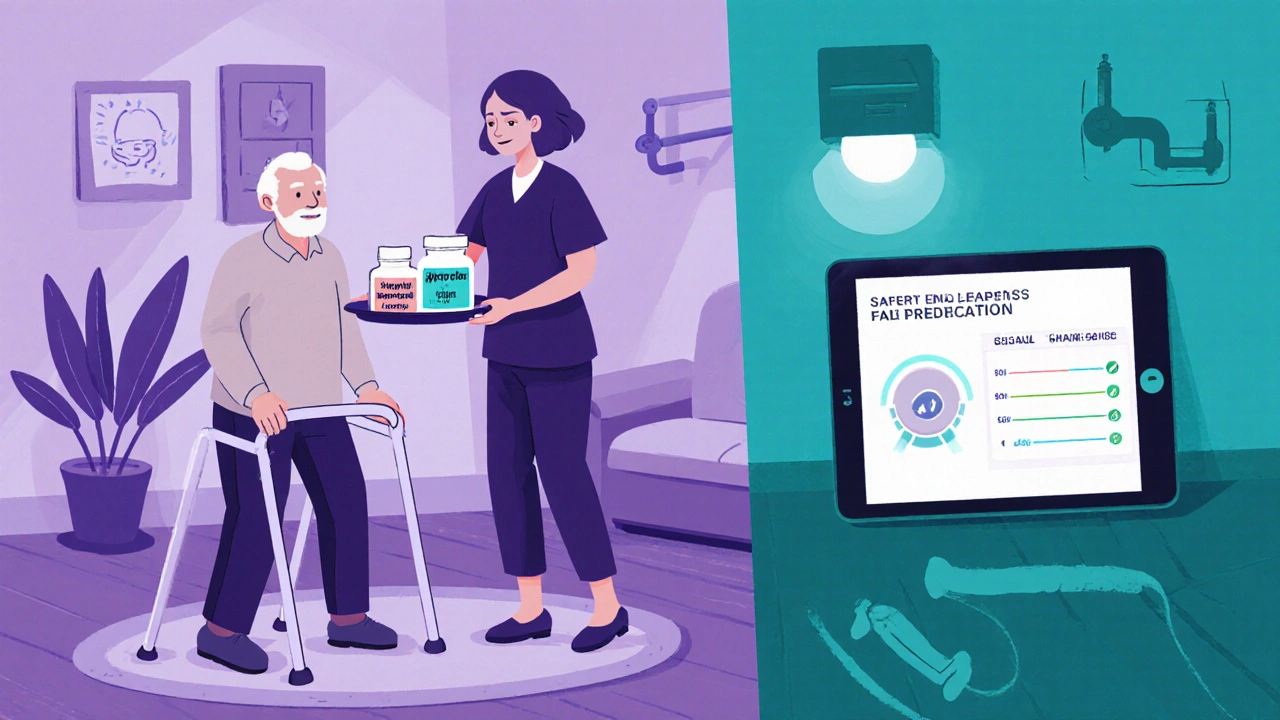Hyponatremia Risk Calculator for Older Adults
This calculator assesses hyponatremia risk in older adults prescribed SSRIs based on key clinical factors. Use it to identify high-risk patients for targeted monitoring and safer antidepressant alternatives.
Key Takeaways
- SSRI use in people 65+ raises hyponatremia risk by about two‑fold, especially within the first month.
- Low baseline sodium, thiazide diuretics, low BMI and female sex amplify the danger.
- Baseline serum sodium, a 2‑week follow‑up test, and medication reconciliation cut emergency visits by ~20% in well‑run programs.
- When hyponatremia is mild (125‑134 mmol/L), stop the SSRI and restrict fluids; severe cases need hospital‑based correction.
- Safer antidepressant options such as mirtazapine or bupropion dramatically reduce hyponatremia risk and may lower fall rates.
When prescribing Selective serotonin reuptake inhibitors (SSRIs) a class of antidepressants that increase serotonin signaling in the brain, clinicians must watch for a hidden danger: hyponatremia. In older adults, this electrolyte imbalance often shows up as shaky gait, dizziness, or confusion-exactly the symptoms that lead to falls. Below is a practical, step‑by‑step guide to keep older patients on antidepressants safely.
Why SSRIs are Frequently Used in Older Adults
Depression and anxiety affect roughly 15‑20 % of Americans aged 65 and older, according to CDC data from 2023. SSRIs dominate the prescribing landscape because they are generally well‑tolerated, have few drug‑food interactions, and can be started at low doses. Their simplicity makes them attractive for primary‑care clinicians, home‑health nurses, and caregivers alike.
Understanding Hyponatremia and Its Link to SSRIs
Hyponatremia is defined as a serum sodium concentration below 135 mmol/L. In the senior population, a systematic review published in 2024 found an odds ratio of 2.158 for SSRIs versus non‑users, translating to a pooled event rate of 5.98 %.
Most cases arise from SSRI‑induced syndrome of inappropriate antidiuretic hormone secretion (SIADH) excess ADH release that forces kidneys to retain water, diluting sodium. The excess water expands extracellular volume without changing total body sodium, so the concentration drops.
The problem usually appears within two to four weeks after the first dose or a dose increase. Because older kidneys have reduced glomerular filtration and altered ADH regulation, they cannot compensate as efficiently as younger adults.
Identifying High‑Risk Patients
Not every senior on an SSRI will develop hyponatremia. Look for these red flags:
- Baseline serum sodium < 140 mmol/L (even a mildly low value matters).
- Body‑mass index below 25 kg/m².
- Concurrent thiazide diuretics a class of diuretics that increase sodium loss in urine.
- Female sex (trend toward higher odds in several studies).
- History of SIADH or chronic kidney disease.
In a Medicare‑beneficiary analysis, the adjusted odds ratio for hyponatremia jumped to 1.24 when a thiazide and an SSRI were combined.
Monitoring Protocols: What the Evidence Says
Traditional guidance (JAMA Internal Medicine, 2011; Carlat Psychiatry Report, 2024) recommends:
- Obtain a baseline serum sodium before starting the SSRI.
- Repeat the test 1‑2 weeks after initiation or any dose change.
- Repeat again at 4‑6 weeks for high‑risk patients.
However, a 2023 AGS Journal study found that early monitoring did NOT reduce hospitalizations for hyponatremia. The discrepancy likely stems from two gaps:
- Even when low sodium is detected, many clinicians continue the SSRI without fluid restriction.
- Follow‑up of abnormal results is often delayed by busy clinic workflows.
Real‑world programs that pair testing with an electronic alert for high‑risk drug combos (e.g., the ASHP decision‑support tool used in 127 hospitals) have cut risky prescribing by 18.7 % and lowered emergency visits by about 22 %.
Safer Antidepressant Alternatives
If the risk outweighs the benefit, consider switching to an agent with a lower hyponatremia profile. The following table summarizes the most common options.
| Drug | Class | Hyponatremia Event Rate | Typical Indication in Seniors |
|---|---|---|---|
| Fluoxetine | SSRI | 6.51 % | Depression, OCD |
| Mirtazapine | \nNaSSA | 0.3 % | Depression with insomnia or poor appetite |
| Bupropion | NDRI | 0.6 % | Depression, smoking cessation |
| Venlafaxine | SNRI | 5.66 % | Depression, anxiety |
Both mirtazapine and bupropion sit well below the 5‑% threshold seen with most SSRIs, making them attractive first‑line choices for patients with any of the high‑risk factors listed earlier.
Managing Hyponatremia When It Occurs
Once low sodium is confirmed, act fast:
- Mild hyponatremia (125‑134 mmol/L): discontinue the SSRI, impose fluid restriction (≈1 L/day), and monitor sodium daily for 48‑72 hours.
- Moderate (115‑124 mmol/L) or severe (<115 mmol/L): admit to hospital, correct sodium slowly (no more than 8‑10 mmol/L in 24 hours) to avoid osmotic demyelination.
- Consider hypertonic saline only under specialist supervision.
Simultaneously review other meds that can exacerbate water retention-especially thiazides, carbamazepine, or certain antipsychotics.

Linking Hyponatremia to Falls and How to Break the Chain
Even mild hyponatremia can cause gait instability and dizziness. A quality‑improvement project at Johns Hopkins Bayview showed a 22 % drop in hyponatremia‑related emergency visits after implementing a bundled protocol of testing, patient education, and prompt drug discontinuation.
Practical steps to curb falls:
- Ask patients to report any new “feeling off,” especially unsteady walking.
- Provide a simple handout that links low sodium symptoms to fall risk.
- Ensure home‑safety assessments (grab bars, proper lighting) are done when hyponatremia is detected.
- If the patient has a recent fall, re‑evaluate the antidepressant choice immediately.
Implementation Checklist for Clinics and Care Homes
- Baseline serum sodium before SSRI start.
- Automated lab order for repeat sodium at 14 days (EHR alert).
- Medication reconciliation to flag thiazide‑SSRI combos.
- Standard patient education sheet about dizziness, confusion, and gait changes.
- Protocol for stopping SSRI and restricting fluids if Na < 135 mmol/L.
- Referral pathway to nephrology or geriatrics for severe cases.
Embedding these steps into the clinic workflow usually requires a single champion-often a pharmacist-who can train staff and monitor compliance.
Future Directions
The Geriatric Antidepressant Safety Collaborative, launched in 2024, is building an AI risk‑prediction tool that ingests baseline sodium, medication list, and fall history. Early pilots suggest a 15 % improvement in identifying patients who truly need intensive monitoring.
Meanwhile, the American Geriatrics Society (AGS) updated its 2024 guidelines to recommend that clinicians weigh fall history alongside hyponatremia risk when picking an antidepressant. Until the NIH‑funded R01AG084321 study reports back, the safest route remains individualized risk assessment combined with clear patient communication.
How soon after starting an SSRI should I check serum sodium?
A baseline level is essential, followed by a repeat test at about 10‑14 days. If the patient is high‑risk (e.g., on a thiazide), add a 4‑week check.
Can I continue an SSRI if my sodium is 133 mmol/L but the patient feels fine?
Most experts advise stopping the SSRI and restricting fluids. Even “asymptomatic” hyponatremia can impair balance and increase fall risk.
Which antidepressant has the lowest hyponatremia risk?
Mirtazapine consistently shows the lowest event rate (≈0.3 %). Bupropion is also low (≈0.6 %) and may be preferred if insomnia isn’t a major issue.
What is the best way to educate patients about hyponatremia symptoms?
Give a one‑page handout that lists “feeling dizzy, unsteady, confused, or unusually weak” as warning signs, and instruct patients to call their provider immediately.
Do thiazide diuretics always need to be stopped when an SSRI is started?
Not always, but the combination raises hyponatremia odds to >1.2. If the patient needs a thiazide, consider close sodium monitoring and possibly switching the antidepressant.
By pairing vigilant sodium monitoring with smarter drug choices and clear patient education, clinicians can keep the benefits of antidepressant therapy while dramatically cutting the twin threats of hyponatremia and falls.
SSRIs remain a valuable tool, but only when used with the safeguards outlined above.

Comments (4)